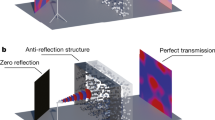Abstract
We study the mathematical treatment of transmission statistics of coupled wave devices with random imperfections. Such devices include multi-mode waveguides or optical fibers, directional couplers at waveguide or optical frequencies, dominant-wave transmission lines (with the reflected wave the spurious mode), lumped filters composed of circuit or of waveguide elements, multi-layer optical coatings to achieve high or low reflectivity.
If the random parameters have very rapid spatial variations, we assume they have white spectra. Exact results for transmission statistics are obtained in such cases. These exact results can be extended to random parameters with almost-white spectra, and narrow-band spectra that are far from white.
These calculations are carried out in a simple way by using Kronecker matrix products.
Similar content being viewed by others
References
H.E. Rowe and W.D. Warters, Transmission in multimode waveguide with random imperfections. Bell System Technical Journal 41 (May 1962) 1031–1170 (Section 2.3.3).
H.E. Rowe, Approximate solutions for the coupled line equations. Bell System Technical Journal 41 (May 1962) 1011–1029.
R. Bellman, Introduction to Matrix Analysis. McGraw-Hill, New York (1970) Chs. 12 and 15.
F.A. Graybill, Introduction to Matrices with Applications in Statistics. Wadsworth, Belmont, Calif. (1969) Section 8.8.
H.E. Rowe and D.T. Young, Transmission distortion in multimode random waveguides. IEEE Transactions on Microwave Theory and Techniques MTT-20 (June 1972) 349–365.
D.T. Young and H.E. Rowe, Optimum coupling for random guides with frequency-dependent coupling. IEEE Transactions on Microwave Theory and Techniques MTT-20 (June 1972) 365–372.
W.B. Davenport and W.L. Root, Random Signals and Noise. McGraw-Hill, New York (1958) Ch. 8.
Ref. [7], Ch. 6.
D. Marcuse, Theory of Dielectric Optical Waveguides. Academic, New York and London (1974) Ch. 5.
J.A. Morrison and J. McKenna, Coupled line equations with random coupling. Bell System Technical Journal 51 (January 1972) 209–228.
Ref. [7], Ch. 7.
H.E. Rowe, Signals and Noise in Communication Systems. Van Nostrand Reinhold, New York (1965) Section 1.5.
D. Marcuse, Coupled power equations for Lossy fibers. Applies Optics 17 (Oct. 15, 1978) 3232–3237.
H.E. Rowe, Propagation in one-dimensional random media. IEEE Transactions on Microwave Theory and Techniques MTT-19 (January 1971) 73–80.
Harrison E. Rowe and Iris M. Mack, Coupled modes with random propagation constants. Radio Science 16 (July–August 1981) 485–493.
S.D. Personick, Time dispersion in dielectric waveguides. Bell System Technical Journal 50 (March 1971) 843–859.
L.A. Denger, Coupled-wave equations with three or more elements. Journal of Applied Physics 45 (August 1974) 3394–3395.
Author information
Authors and Affiliations
Rights and permissions
About this article
Cite this article
Rowe, H.E. Waves with random coupling and random propagation constants. Appl. Sci. Res. 41, 237–255 (1984). https://doi.org/10.1007/BF00382455
Issue Date:
DOI: https://doi.org/10.1007/BF00382455




